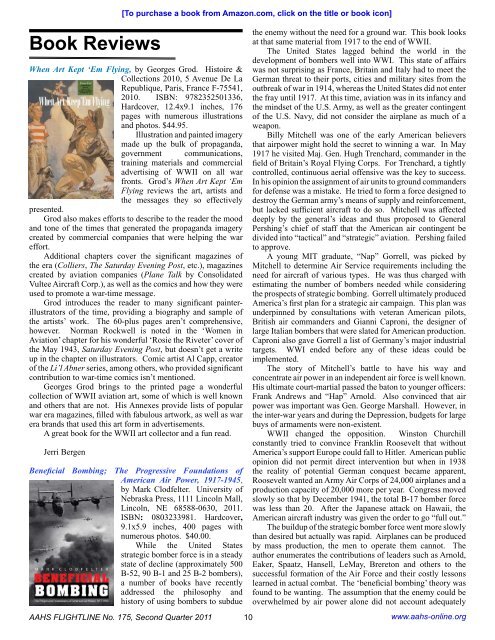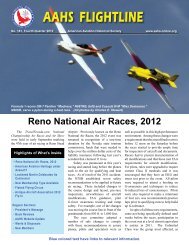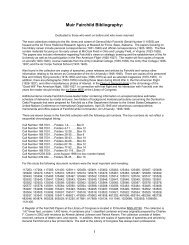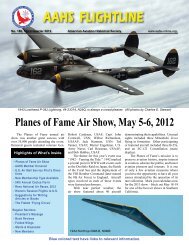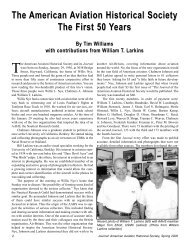AAHS FLIGHTLINE - American Aviation Historical Society
AAHS FLIGHTLINE - American Aviation Historical Society
AAHS FLIGHTLINE - American Aviation Historical Society
Create successful ePaper yourself
Turn your PDF publications into a flip-book with our unique Google optimized e-Paper software.
Book Reviews<br />
When Art Kept ‘Em Flying, by Georges Grod. Histoire &<br />
Collections 2010, 5 Avenue De La<br />
Republique, Paris, France F-75541,<br />
2010. ISBN: 9782352501336,<br />
Hardcover, 12.4x9.1 inches, 176<br />
pages with numerous illustrations<br />
and photos. $44.95.<br />
Illustration and painted imagery<br />
made up the bulk of propaganda,<br />
government communications,<br />
training materials and commercial<br />
advertising of WWII on all war<br />
fronts. Grod’s When Art Kept ‘Em<br />
Flying reviews the art, artists and<br />
the messages they so effectively<br />
presented.<br />
Grod also makes efforts to describe to the reader the mood<br />
and tone of the times that generated the propaganda imagery<br />
created by commercial companies that were helping the war<br />
effort.<br />
Additional chapters cover the signifi cant magazines of<br />
the era (Colliers, The Saturday Evening Post, etc.), magazines<br />
created by aviation companies (Plane Talk by Consolidated<br />
Vultee Aircraft Corp.), as well as the comics and how they were<br />
used to promote a war-time message.<br />
Grod introduces the reader to many signifi cant painterillustrators<br />
of the time, providing a biography and sample of<br />
the artists’ work. The 60-plus pages aren’t comprehensive,<br />
however. Norman Rockwell is noted in the ‘Women in<br />
<strong>Aviation</strong>’ chapter for his wonderful ‘Rosie the Riveter’ cover of<br />
the May 1943, Saturday Evening Post, but doesn’t get a write<br />
up in the chapter on illustrators. Comic artist Al Capp, creator<br />
of the Li’l Abner series, among others, who provided signifi cant<br />
contribution to war-time comics isn’t mentioned.<br />
Georges Grod brings to the printed page a wonderful<br />
collection of WWII aviation art, some of which is well known<br />
and others that are not. His Annexes provide lists of popular<br />
war era magazines, fi lled with fabulous artwork, as well as war<br />
era brands that used this art form in advertisements.<br />
A great book for the WWII art collector and a fun read.<br />
Jerri Bergen<br />
[To purchase a book from Amazon.com, click on the title or book icon]<br />
Benefi cial Bombing; The Progressive Foundations of<br />
<strong>American</strong> Air Power, 1917-1945,<br />
by Mark Clodfelter. University of<br />
Nebraska Press, 1111 Lincoln Mall,<br />
Lincoln, NE 68588-0630, 2011.<br />
ISBN: 0803233981. Hardcover,<br />
9.1x5.9 inches, 400 pages with<br />
numerous photos. $40.00.<br />
While the United States<br />
strategic bomber force is in a steady<br />
state of decline (approximately 500<br />
B-52, 90 B-1 and 25 B-2 bombers),<br />
a number of books have recently<br />
addressed the philosophy and<br />
history of using bombers to subdue<br />
the enemy without the need for a ground war. This book looks<br />
at that same material from 1917 to the end of WWII.<br />
The United States lagged behind the world in the<br />
development of bombers well into WWI. This state of affairs<br />
was not surprising as France, Britain and Italy had to meet the<br />
German threat to their ports, cities and military sites from the<br />
outbreak of war in 1914, whereas the United States did not enter<br />
the fray until 1917. At this time, aviation was in its infancy and<br />
the mindset of the U.S. Army, as well as the greater contingent<br />
of the U.S. Navy, did not consider the airplane as much of a<br />
weapon.<br />
Billy Mitchell was one of the early <strong>American</strong> believers<br />
that airpower might hold the secret to winning a war. In May<br />
1917 he visited Maj. Gen. Hugh Trenchard, commander in the<br />
fi eld of Britain’s Royal Flying Corps. For Trenchard, a tightly<br />
controlled, continuous aerial offensive was the key to success.<br />
In his opinion the assignment of air units to ground commanders<br />
for defense was a mistake. He tried to form a force designed to<br />
destroy the German army’s means of supply and reinforcement,<br />
but lacked suffi cient aircraft to do so. Mitchell was affected<br />
deeply by the general’s ideas and thus proposed to General<br />
Pershing’s chief of staff that the <strong>American</strong> air contingent be<br />
divided into “tactical” and “strategic” aviation. Pershing failed<br />
to approve.<br />
A young MIT graduate, “Nap” Gorrell, was picked by<br />
Mitchell to determine Air Service requirements including the<br />
need for aircraft of various types. He was thus charged with<br />
estimating the number of bombers needed while considering<br />
the prospects of strategic bombing. Gorrell ultimately produced<br />
America’s fi rst plan for a strategic air campaign. This plan was<br />
underpinned by consultations with veteran <strong>American</strong> pilots,<br />
British air commanders and Gianni Caproni, the designer of<br />
large Italian bombers that were slated for <strong>American</strong> production.<br />
Caproni also gave Gorrell a list of Germany’s major industrial<br />
targets. WWI ended before any of these ideas could be<br />
implemented.<br />
The story of Mitchell’s battle to have his way and<br />
concentrate air power in an independent air force is well known.<br />
His ultimate court-martial passed the baton to younger offi cers:<br />
Frank Andrews and “Hap” Arnold. Also convinced that air<br />
power was important was Gen. George Marshall. However, in<br />
the inter-war years and during the Depression, budgets for large<br />
buys of armaments were non-existent.<br />
WWII changed the opposition. Winston Churchill<br />
constantly tried to convince Franklin Roosevelt that without<br />
America’s support Europe could fall to Hitler. <strong>American</strong> public<br />
opinion did not permit direct intervention but when in 1938<br />
the reality of potential German conquest became apparent,<br />
Roosevelt wanted an Army Air Corps of 24,000 airplanes and a<br />
production capacity of 20,000 more per year. Congress moved<br />
slowly so that by December 1941, the total B-17 bomber force<br />
was less than 20. After the Japanese attack on Hawaii, the<br />
<strong>American</strong> aircraft industry was given the order to go “full out.”<br />
The buildup of the strategic bomber force went more slowly<br />
than desired but actually was rapid. Airplanes can be produced<br />
by mass production, the men to operate them cannot. The<br />
author enumerates the contributions of leaders such as Arnold,<br />
Eaker, Spaatz, Hansell, LeMay, Brereton and others to the<br />
successful formation of the Air Force and their costly lessons<br />
learned in actual combat. The ‘benefi cial bombing’ theory was<br />
found to be wanting. The assumption that the enemy could be<br />
overwhelmed by air power alone did not account adequately<br />
<strong>AAHS</strong> <strong>FLIGHTLINE</strong> No. 175, Second Quarter 2011 10<br />
www.aahs-online.org


